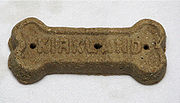
Dog biscuit
Encyclopedia

Biscuit
A biscuit is a baked, edible, and commonly flour-based product. The term is used to apply to two distinctly different products in North America and the Commonwealth Nations....
-based dietary supplement
Dietary supplement
A dietary supplement, also known as food supplement or nutritional supplement, is a preparation intended to supplement the diet and provide nutrients, such as vitamins, minerals, fiber, fatty acids, or amino acids, that may be missing or may not be consumed in sufficient quantities in a person's diet...
for dog
Dog
The domestic dog is a domesticated form of the gray wolf, a member of the Canidae family of the order Carnivora. The term is used for both feral and pet varieties. The dog may have been the first animal to be domesticated, and has been the most widely kept working, hunting, and companion animal in...
s or other canine
Canidae
Canidae is the biological family of carnivorous and omnivorous mammals that includes wolves, foxes, jackals, coyotes, and domestic dogs. A member of this family is called a canid . The Canidae family is divided into two tribes: Canini and Vulpini...
, similar to human snack food
Snack food
A snack is a portion of food oftentimes smaller than that of a regular meal, that is generally eaten between meals. Snacks come in a variety of forms including packaged and processed foods and items made from fresh ingredients at home....
.
Dog biscuits tend to be hard and dry. Dog biscuits may be sold in a flat bone-shape. Some manufacturers claim the dry and hard biscuit texture helps clean the dog's teeth, promoting oral health.
History
"Dog's bread", made from branBran
Bran is the hard outer layer of grain and consists of combined aleurone and pericarp. Along with germ, it is an integral part of whole grains, and is often produced as a by-product of milling in the production of refined grains. When bran is removed from grains, the grains lose a portion of their...
, has been mentioned since at least Roman times. It was already criticized (as in later centuries) as particularly bad bread; Juvenal
Juvenal
The Satires are a collection of satirical poems by the Latin author Juvenal written in the late 1st and early 2nd centuries AD.Juvenal is credited with sixteen known poems divided among five books; all are in the Roman genre of satire, which, at its most basic in the time of the author, comprised a...
refers to dog's bread as "filth" - "And bit into the filth of a dog's bread" Et farris sordes mordere Canini.
In Spain, "pan de perro" is mentioned as early as 1623 in a play by Lope de Vega
Lope de Vega
Félix Arturo Lope de Vega y Carpio was a Spanish playwright and poet. He was one of the key figures in the Spanish Golden Century Baroque literature...
. It is used here in the sense of giving someone blows; to "give dog's bread" to someone could mean anything from mistreating them to killing them. The latter meaning refers to a special bread (also called zarazas) made with ground glass, poison and needles and intended to kill dogs.
The bread meant as food for dogs was also called parruna and was made from bran. This was very likely what was referred to in associating the bread with (non-fatal) mistreatment.
In France, Charles Estienne wrote in 1598: "Take no notice of bran bread,... it is better to leave it for the hunting, or shepherd, or watch dogs." By the nineteenth century, "pain de chien" had become a way of referring to very bad bread: "It is awful, general, they give us dog's bread!".
The English dog biscuit appears to be a nineteenth century innovation: "With this may be joined farinaceous and vegetable articles — oat-meal, fine-pollard, dog-biscuit, potatoes, carrots, parsnips" (1827); "being in the neighbourhood of Maidenhead, I inspected Mr. Smith's dog-biscuit manufactory, and was surprised to find he has been for a long period manufacturing the enormous quantity of five tons a-week !" (1828)
In later years, dog biscuits began to be made of meat products and were sometimes treated as synonymous with dog food
Dog food
Dog food refers to food specifically intended for consumption by dogs. Though technically omnivorous, dogs exhibit a natural carnivorous bias, have sharp, pointy teeth, and have short gastrointestinal tracts better suited for the consumption of meat...
. In 1871, an ad appeared in Cassell's Illustrated Almanac for "SLATER'S MEAT BISCUIT FOR DOGS - Contains vegetable substances and about 25 per cent of Prepared Meat. It gives Dogs endurance, and without any other food will keep them in fine working condition."
In England, Spratt's Dog Biscuits not only obtained a patent but seems to have claimed to have invented the food:
In at least one case (in 1886) Spratt sued a seller accused of substituting another product - an early example of a company fighting "knock-offs":
Spratt lost in this case and the judge regretted that he could not grant the defendant court costs.
At one point after this, as an industrial product, dog biscuits were classified in the same category as soap: "Of the making of dog biscuits, which the census places in the same category with soap, as using animal refuse from which soap grease has been extracted, it is unnecessary to say much."
Spratt dominated the American market until 1907, when F. H. Bennett, whose own dog biscuits were faring poorly against those of the larger company, had the idea of making them in the shape of a bone. "His 'Maltoid Milk-Bones' were such a success that for the next fifteen years Bennett's Milk-Bone dominated the commercial dog food market in America." In 1931, the National Biscuit Company (Nabisco) bought the company.

